Minnehaha Falls
|
|
Minnehaha Creek is a short tributary of the Mississippi River located in Hennepin County, Minnesota that extends from Lake Minnetonka in the west and flows east for 22 miles (35 km). Including Lake Minnetonka, the watershed for the creek covers 181 square miles (469 km²). Much of the stream flows through southern Minneapolis. The creek might have been unremarkable except for the 53 foot (16 m) Minnehaha Falls located near the confluence with the Mississippi. The site is not far from Fort Snelling, one of the earliest white settlements in the region.
While the most common translation of the name is "Laughing Water", the name can be broken down into two phrases from the Dakota language: mi-ni for water, and ha-ha for waterfall. The "Laughing Water" translation comes from Mary Eastman's book Dacotah, published in 1849. Early reports from white visitors called the spot Brown's Falls, named for United States Army commander Jacob Brown.
The falls became a tourist destination, especially after the publication of The Song of Hiawatha by Henry Wadsworth Longfellow. However, Longfellow never visited the falls himself. He was inspired by the stories of Mary Eastman and Henry Rowe Schoolcraft and images of the falls.
In geologic time, the site of Minnehaha Falls is linked historically to Saint Anthony Falls, which is several miles upriver on the Mississippi. Around 10,000 years ago, the St. Anthony Falls were located near the site where Minnehaha Creek entered the river. As erosion brought the falls upriver, they passed Minnehaha Creek, causing a new waterfall to form. The story actually becomes even more complex because the Mississippi eventually abandoned the portion of St. Anthony Falls that was then nearest to Minnehaha. The lower portion of Minnehaha Creek now flows through a wide and deep channel once belonging to the larger river.
Erosion within the last century has resulted in a falls that is fairly narrowly channeled and vigorous, notably after a heavy rain when the creek level rises. Photographs of the waterfall from the late 1800s and early 1900s indicate a much wider and more curtainlike character to the falls.
Today, the falls are located near the entrance of Minnehaha Park in Minneapolis. The park is divided into two main portions, an upper section above the falls which is kept trimmed and maintained like many other city parks, and the lower section which is largely left in a natural state. Minnehaha Park is a popular site for cultural festivities and weddings.
Some historic structures are located in the park. The home of John H. Stevens, the first resident of Minneapolis, was moved there in 1896. A small train station officially named Minnehaha Depot but also known as "the Princess Depot" is also in the park. Once belonging to the Milwaukee Road, the depot provided easy access to the park and was once integrated into the region's streetcar system. It is across the street from the modern light rail station that serves the park. A building known as the Longfellow House is also on the park grounds and provides some history of the park and is the main informational site for the Grand Rounds Scenic Byway, a 50-mile automobile, bicycle, and pedestrian parkway that circles through the city. The byway also has a roundabout at the location, which is a rare sight in the state.
Statues on the grounds commemorate several notable figures including John Stevens, Gunnar Wennerberg, Hiawatha and Minnehaha, Little Crow, and Henry Wadsworth Longfellow.
The main Minnesota Veterans Home is also located in the area.
References
- Minnehaha Regional Park. (http://www.nps.gov/miss/maps/model/minnehaha.html) National Park Service. Accessed July 17, 2004.

